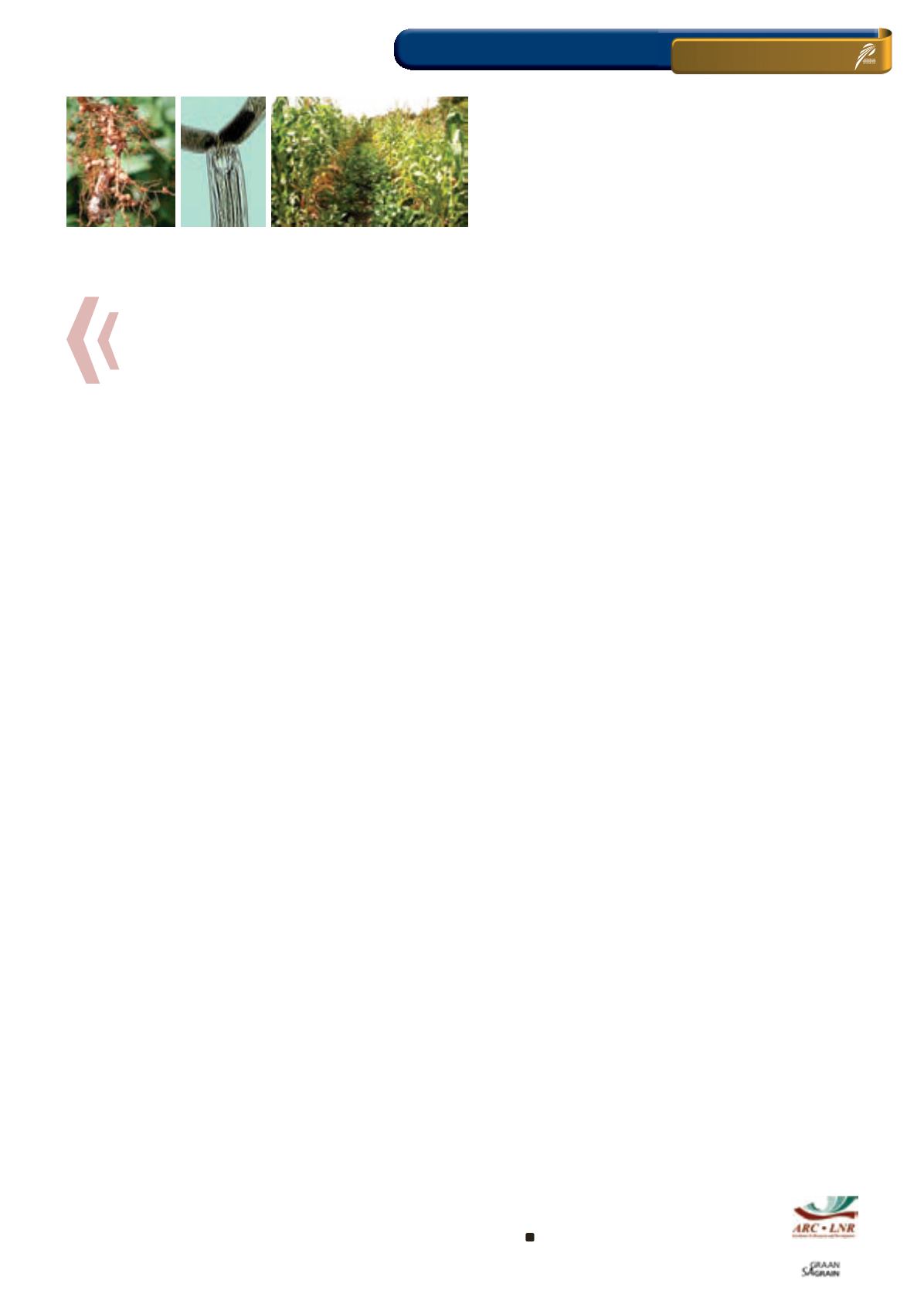
119
September 2014
ON FARM LEVEL
Conservationagriculture
It is generally argued that a high diversity of SMCs in an ecosystem
will increase the ecosystem’s potential to function more efficiently
under a variety of environmental conditions, implying an increased
level of resilience.
Essentially, this means that there are several groups of soil organ-
isms performing different functions in the soil, instead of only a
single group of organisms doing everything. If external influences
should have a detrimental effect onone groupof organisms, the re-
maining groupswill pick up the slack. Different crops have different
root structures, placing organic matter in different soil strata, thus
fertilising the soil.
Owing to the interaction between plant roots andmicro-organisms
in the rhizosphere, soil fertility, crop health and yield are affected
by initiating improved nutrient cycling, disease resistance and plant
growth stimulation. Crop rotation with leguminous crops reduces
the need for expensive nitrogen fertiliser. Changes in planting dates
might also contribute todisease control.
Soil disturbance
Tillage not only alters a soil’s chemical and physical characteristics,
but also the spatial integrityof the soil as a supportmatrix for SMCs.
Conventional-tillage was initially supposed to substitute “biological
ploughing” by earthworms.
Contrary to initial good intentions, tillage destroys pores left by soil
organism activity and plant roots, disrupts fungal growth through
soil matrix, and kills earthworms. Earthworms constitute a vital
part of soil health assessment during the conversion from intensive
ploughing toCA.
Nematodes are also considered important biological indicators of
soil fertility. Routine analyses of soil nematodes provides a rapid as-
sessment of responses tomanagement activity and environmental
stresses. Increased levels of agricultural management result in de-
creased nematode diversity. The consequence of this is reflected in
bothphysical disturbance and changes in thequality andquantityof
organicmatter being returned to the soil, and alsopossible increas-
es in specific crop-associatedplant parasitic nematodes.
Soil organic matter in a no-till system is mainly decomposed by
fungi. Conventional-tillage drastically alters soil organic matter de-
composition by breaking up crop residues into smaller pieces and
redistributing it throughout theploughed layer, establishingbacteria
asprimarydecomposersof soil organicmatter. The redistributionof
broken-up crop residues does not only increasemicrobial colonisa-
tion, it also enhances aeration.
Soil organic matter is consequently oxidised when exposed to air
by tillage. Combined with the removal of produced organic matter
during harvesting, tillage results in reduced organicmatter content,
unless additional organic matter is returned to the soil as residues
or compost. In contrast tominimum-till (or no-till), conventional-till-
age accelerates nutrient cycling, consequently increasing nitrogen
mineralisation and soil carbon loss. Correct agricultural manage-
ment can therefore be implemented to ensure effective nitrogen
mineralisation through minimum-till, which minimises soil erosion
and compaction.
Residue retention (mulching)
Plantsprotect the soil. Everyyear 13millionhaof forest is cut down.
When these virgin (undisturbed) lands are converted for agricultural
(disturbed) use, soil organicmatter content decreases annually until
it stabilises at amuch reduced concentration, influencing soilmicro-
bial functioning.
Build-up of soil organic matter through residue retention retains
nutrients and increases microbial diversity and activity in soil. The
quality and quantity of soil organic matter entering the soil greatly
influences soil microbial processes. Care should however be taken
whenhigh-carbonplantmaterial is applied as a residue.
High-carbonplantmaterial shouldbe compostedormixedwithma-
nure prior to soil application, since high-carbon compounds (high
C:N ratio) take longer toundergodecompositionbySMCs thancom-
poundswith a lower carbon content (higher nitrogen content).
Several long-term studies have shown that residue retention in
combinationwithminimum soil disturbance creates favourable con-
ditionsandpromotesecological stabilityand the increaseof antago-
nists and predators (which facilitate integrated pest management
andbiological control).
This is in contrast with the absence of residue which leads to poor
soil fertility. It is also important to note that while surface mulch
moderates soilmoisture and temperature, favourable conditions are
also created for microbial activity and biological diversity with in-
creased amounts of beneficial insects under groundcover to assist
in insect pestmanagement.
Several studies have found more beneficial soil fauna (micro-
organisms, earthworms, nematodes) under no-till and residue-pre-
servation management strategies, when compared to treatments
subjected to conventional-tillage. It is known that healthy soil
with ahighmicrobial diversityhas apositive impact ondisease sup-
pression.
By applying the correct agricultural management as prescribed for
CA, the soil ecosystem is granted the opportunity tonurture natural
biological control measures during the build-up of soil cover. This
improvedunderstandingwill thereforebe fundamental in theprotec-
tion of our natural resources through the promotion of a balanced
ecosystem that would inevitably lead to increased soil microbial ac-
tivityanddiversity, soil fertilityand sustainablemanagement of crop
production.
Although numerous techniques have been developed to provide
valuable information regarding current soil activities and specific
processes, few have been integrated to enhance a holistic under-
standingof ecosystem functions.
Combining basic research/knowledge (i.e. ecology and molecular
biology) with current knowledge of healthy ecosystems, could lay
the foundation for the development of microbe-based sustainable
agriculture.
For enquiries, contact Johan Habig at
HabigJ@arc.
agric.za
.
Soil biology’s inϐluenceon soil fertility


